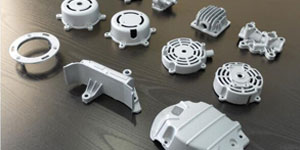Machining parts are mechanical parts processed by various mechanical processing equipment, mainly referring to processing methods that do not undergo chemical reactions (or reactions are very small). There are two main types of mechanical processing: manual processing and numerical control processing.
Manual processing refers to the method of processing various materials by manual operation of mechanical equipment such as milling machines, lathes, drilling machines, and sawing machines by mechanical workers. Manual processing is suitable for small batch and simple part production.
Numerical control processing (CNC) refers to the use of numerical control equipment for machining by mechanical workers. These numerical control equipment includes machining centers, turning and milling centers, wire EDM equipment, thread cutting machines, etc. Cnc Machining processes workpieces in a continuous manner, which is suitable for large-volume, complex-shaped parts.
List of Contents
Technical requirements for machining

1. Tolerance requirements
- (1) Unmarked shape tolerances should meet the requirements of GB1184-80.
- (2) The allowable deviation of the unmarked length dimension is ±0.5mm.
- (3) The casting tolerance zone is symmetrical to the basic size configuration of the rough casting.
2. Requirements for cutting parts
- The parts should be inspected and accepted according to the procedure, and can be transferred to the next procedure only after the previous procedure has passed the inspection.
- The processed parts are not allowed to have burrs.
- The finished parts shall not be placed directly on the ground when placed, and necessary support and protection measures shall be taken. The machined surface is not allowed to have
- defects such as rust, bumps and scratches that affect performance, life or appearance.
- The surface processed by rolling shall not peel off after rolling.
- There should be no oxide scale on the surface of the parts after heat treatment in the final process. Finished mating surfaces and tooth surfaces should not be annealed
- The surface of the processed thread is not allowed to have defects such as black skin, bumps, random buckles and burrs.
What is precision machining?
Precision machining is a kind of machining. This is a machining process in which the workpiece meets the position tolerance required by the drawing. When the workpiece undergoes this process, its performance characteristics and appearance structure will change to a certain extent.
If there is mechanical processing, there will naturally be corresponding parts. As a discipline of mechanical major, mechanical parts design is one of the popular majors selected by science students and one of the strongest engineering disciplines. At present, this major needs not only good Knowledge of science and engineering requires excellent drawing ability and spatial imagination ability. And due to the development of domestic industry and the continuous changes in demand, the demand for personnel in the machining industry is also increasing, and the employment rate of mechanical majors can reach 95% .
With the development and progress of domestic industry, machining has changed a lot, and precision machining technology has also emerged. Many industries such as home appliances, automobiles, hardware, and products used in medical manufacturing more or less use precision parts. It may be just a component, or it may be the core component of a mechanical device. All in all, it is very important and plays an irreplaceable role.
There are two processes for precision machining and manufacturing of these precision parts. One is hot processing and the other is cold processing. Hot processing is to make the parts undergo chemical or physical changes under very warm conditions to meet the requirements of shape changes through heat treatment and other methods. For cold working, there is no chemical and physical change at room temperature to meet the requirements of shape change, and cutting technology is generally used. In the future, under the premise of satisfying processing and environmental protection, precision machining will be combined with technology to become an important and sustainable science.
Do you really understand what non-standard precision machined parts are?
Non-standard parts, I believe that the machinery manufacturing industry has the most contact and demand. Most of the specifications and parameters of parts in automation equipment, jigs used in processing, and inspection tools for inspection are freely controlled by enterprises. Therefore, such enterprises will hand over the drawings of the required parts to the corresponding precision machining manufacturers for processing to meet the geometric tolerances required by the drawings.
From the above text, we can draw a vague concept. Non-standard parts are proposed relative to standard parts. It does not already have standardized structure, size, marking and drawing method like standard parts. Non-standard parts mainly It is the accessories that the country has not set strict standard specifications, and there are no relevant parameter regulations, and the enterprises freely control according to the needs of their own production. Therefore, to a certain extent, the processing cost is higher than that of standard parts.
At present, there is no very standardized classification of non-standard parts. They are roughly classified into metal non-standard parts and non-metal non-standard parts according to their materials. Metal parts are raw materials such as brass, aluminum, etc., and tolerance requirements and finish are specified by the customer , The process is complicated, and the non-metal parts are raw materials such as plastic, wood and stone.
Please keep the source and address of this article for reprinting:Cnc Machining
Reprint Statement: If there are no special instructions, all articles on this site are original. Please indicate the source for reprinting.:Cnc Machine Wiki,Thanks!^^
